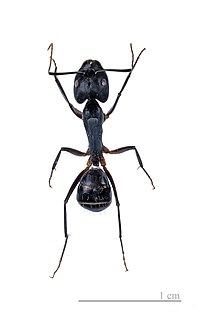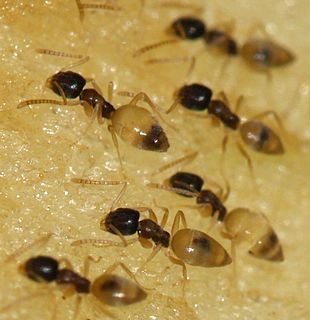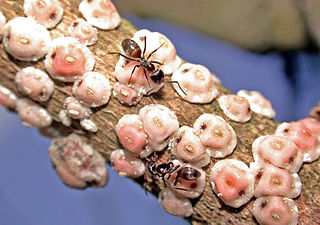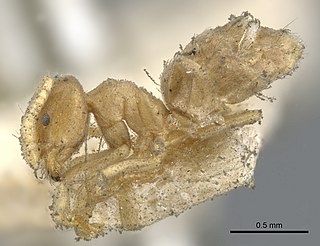
The Formicinae are a subfamily within the Formicidae containing ants of moderate evolutionary development.

Myrmicinae is a subfamily of ants, with about 140 extant genera; their distribution is cosmopolitan. The pupae lack cocoons. Some species retain a functional sting. The petioles of Myrmicinae consist of two nodes. The nests are permanent and in soil, rotting wood, under stones, or in trees.

Dolichoderinae is a subfamily of ants, which includes species such as the Argentine ant, the erratic ant, the odorous house ant, and the cone ant. The subfamily presents a great diversity of species throughout the world, distributed in different biogeographic regions, from the Palearctic, Nearctic, Afrotropical region and Malaysia, to the Middle East, Australian, and Neotropical regions.

Tapinoma is a genus of ants that belongs to the subfamily Dolichoderinae. The genus currently comprises 74 described species distributed worldwide in tropical and temperate regions. Members of are generalized foragers, nesting in a wide variety of habitats, ranging from grasslands, open fields, woodlands, to inside buildings. The majority of species nest in the ground under objects such as stones or tree logs, other species build nests under bark of logs and stumps, in plant cavities, insect galls or refuse piles.

Dorymyrmex is a genus of ants in the subfamily Dolichoderinae.

Aphaenogaster is a genus of myrmicine ants. About 200 species have been described, including 18 fossil species. They occur worldwide except in South America south of Colombia, Sub-Saharan Africa, and Antarctica.

Crematogaster is an ecologically diverse genus of ants found worldwide, which are characterised by a distinctive heart-shaped gaster (abdomen), which gives them one of their common names, the Saint Valentine ant. Members of this genus are also known as cocktail ants because of their habit of raising their abdomens when alarmed. Most species are arboreal. These ants are sometimes known as acrobat ants.

Plagiolepis is an ant genus of the formic acid-producing subfamily Formicinae. The genus is found in tropical and temperate regions of the Old World.

Tetramorium is a genus of ants in the subfamily Myrmicinae that includes more than 520 species.

Dolichoderus is a genus of ants found worldwide.

Cataulacus is a genus of ants in the subfamily Myrmicinae. The genus is distributed in the Paleotropical regions, mainly in the Afrotropics. Most species are found in forests, but a few are known from more open and arid habitats.

Nesomyrmex is a genus of ants in the subfamily Myrmicinae. The genus is distributed in the Neotropical, Afrotropical and Malagasy regions. Most species live in arid climates, but some are known from the rainforest. They nest in soil or in trees. Little is known about their biology.
Chronoxenus butteli is an Indonesian ant of the genus Chronoxenus. It was once considered to be a part of the genus Iridomyrmex, and was moved from there to Chronoxenus. It was described by Forel in 1913.
Chronoxenus walshi is a species of ant of the genus Chronoxenus. It was described by Forel in 1895, and was formerly a part of the genus Iridomyrmex. They are endemic to Bangladesh, India and China.
Chronoxenus dalyi is a species of ant of the genus Chronoxenus. It was described by Forel in 1895. The ant is endemic to Bangladesh, India, Nepal and China.
Chronoxenus wroughtonii is a species of ant of the genus Chronoxenus. It was described by Forel in 1895, and was once apart of the genus Iridomyrmex. They are endemic to China, India and South Korea.














